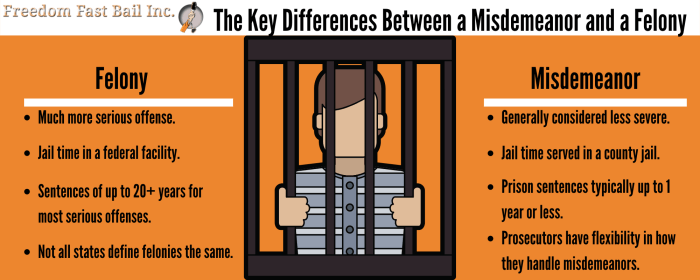What is the difference between felony and misdemeanor larceny?This question sparks a legal inquiry that unravels the distinct characteristics, punishments, and consequences associated with these two types of theft offenses. Our exploration delves into the legal definitions, sentencing guidelines, individual impact, preventive measures, legal procedures, and real-world case studies, providing a comprehensive understanding of the nuances that differentiate felony and misdemeanor larceny.
As we embark on this legal expedition, we will uncover the factors that shape sentencing decisions, the potential consequences for individuals, and the measures employed to prevent and deter these crimes. Through an examination of real-world case studies, we will gain insights into the practical application of legal principles and the impact of these offenses on individuals and society.
1. Legal Definitions
Larceny, commonly known as theft, is a criminal offense involving the unlawful taking and carrying away of personal property from another person’s possession. In the legal context, larceny is categorized into two main types: felony larceny and misdemeanor larceny. The distinction between these two categories lies in the value of the stolen property and the circumstances surrounding the crime.
Felony larcenyis defined as the theft of property with a value exceeding a certain threshold, which varies by jurisdiction. Typically, the threshold is set at $1,000 or $5,000. In addition to the value of the property, other factors that may elevate larceny to a felony include the use of force or intimidation, the theft of a firearm, or the theft of property from a specific location, such as a motor vehicle or a residence.
Misdemeanor larceny, on the other hand, involves the theft of property with a value below the felony threshold. Misdemeanor larceny is generally considered a less serious offense than felony larceny and carries less severe penalties. However, the specific consequences of a misdemeanor larceny conviction may vary depending on the circumstances of the crime and the offender’s criminal history.
2. Punishment and Sentencing

The punishments for felony and misdemeanor larceny vary significantly. Felony larceny is typically punishable by imprisonment in a state prison for a period of years, depending on the value of the stolen property and the offender’s criminal history. In some cases, felony larceny may also be punishable by fines or restitution to the victim.
Misdemeanor larceny, on the other hand, is typically punishable by imprisonment in a county jail for a period of up to one year, or by fines, or both. The specific punishment imposed in a misdemeanor larceny case will depend on the value of the stolen property, the offender’s criminal history, and the circumstances of the crime.
In both felony and misdemeanor larceny cases, the sentencing decision is made by the judge or jury. The judge or jury will consider a variety of factors in determining the appropriate sentence, including the value of the stolen property, the offender’s criminal history, the offender’s remorse, and the impact of the crime on the victim.
3. Impact on Individuals
A conviction for felony or misdemeanor larceny can have a significant impact on an individual’s life. A felony larceny conviction can result in imprisonment, fines, and a permanent criminal record. This can make it difficult to obtain employment, housing, and other benefits.
A misdemeanor larceny conviction can also have negative consequences, although they are typically less severe than the consequences of a felony larceny conviction.
In addition to the legal consequences, a larceny conviction can also have a negative impact on an individual’s reputation and self-esteem. A person who has been convicted of larceny may be viewed as untrustworthy or dishonest, which can make it difficult to maintain relationships and find employment.
4. Prevention and Deterrence

There are a number of measures that can be taken to prevent felony and misdemeanor larceny. These measures include increasing security at homes and businesses, educating the public about larceny prevention, and providing support to individuals who are at risk of committing larceny.
The effectiveness of these measures in deterring larceny is difficult to measure. However, there is some evidence that suggests that these measures can be effective in reducing the incidence of larceny. For example, a study by the National Crime Prevention Council found that a community-based crime prevention program that included a focus on larceny prevention was associated with a 25% reduction in larceny rates.
5. Legal Procedures
The legal procedures involved in felony and misdemeanor larceny cases are similar. In both cases, the prosecution must prove beyond a reasonable doubt that the defendant committed the crime. The prosecution will typically present evidence such as witness testimony, physical evidence, and documentary evidence.
The defendant may choose to plead guilty, plead not guilty, or plead no contest. If the defendant pleads guilty, the judge will sentence the defendant immediately. If the defendant pleads not guilty or no contest, the case will go to trial.
At trial, the prosecution will present its evidence first, followed by the defense. The jury will then deliberate and reach a verdict.
If the defendant is found guilty, the judge will sentence the defendant. The sentence will depend on the severity of the crime and the defendant’s criminal history.
6. Case Studies: What Is The Difference Between Felony And Misdemeanor Larceny

Case Study 1:In 2018, a man was convicted of felony larceny for stealing a car from a dealership. The man had a prior conviction for burglary, which enhanced the charge to a felony. The man was sentenced to five years in prison.
Case Study 2:In 2019, a woman was convicted of misdemeanor larceny for stealing a purse from a store. The woman had no prior criminal history. The woman was sentenced to one year of probation and ordered to pay restitution to the victim.
Question Bank
What are the key differences between felony and misdemeanor larceny?
Felony larceny typically involves the theft of property valued at a higher threshold, resulting in more severe punishments, including imprisonment in a state prison. Misdemeanor larceny, on the other hand, involves the theft of property below a certain value and is generally punishable by fines or imprisonment in a local jail.
How do sentencing decisions differ for felony and misdemeanor larceny?
Sentencing decisions for felony larceny consider factors such as the value of the stolen property, the defendant’s criminal history, and the presence of aggravating or mitigating circumstances. Misdemeanor larceny sentencing typically involves a less formal process and may consider similar factors, but to a lesser extent.
What are the potential consequences of a felony or misdemeanor larceny conviction?
A felony larceny conviction can have severe consequences, including imprisonment, fines, loss of voting rights, and difficulty obtaining employment. Misdemeanor larceny convictions may result in fines, probation, community service, or a combination thereof.

